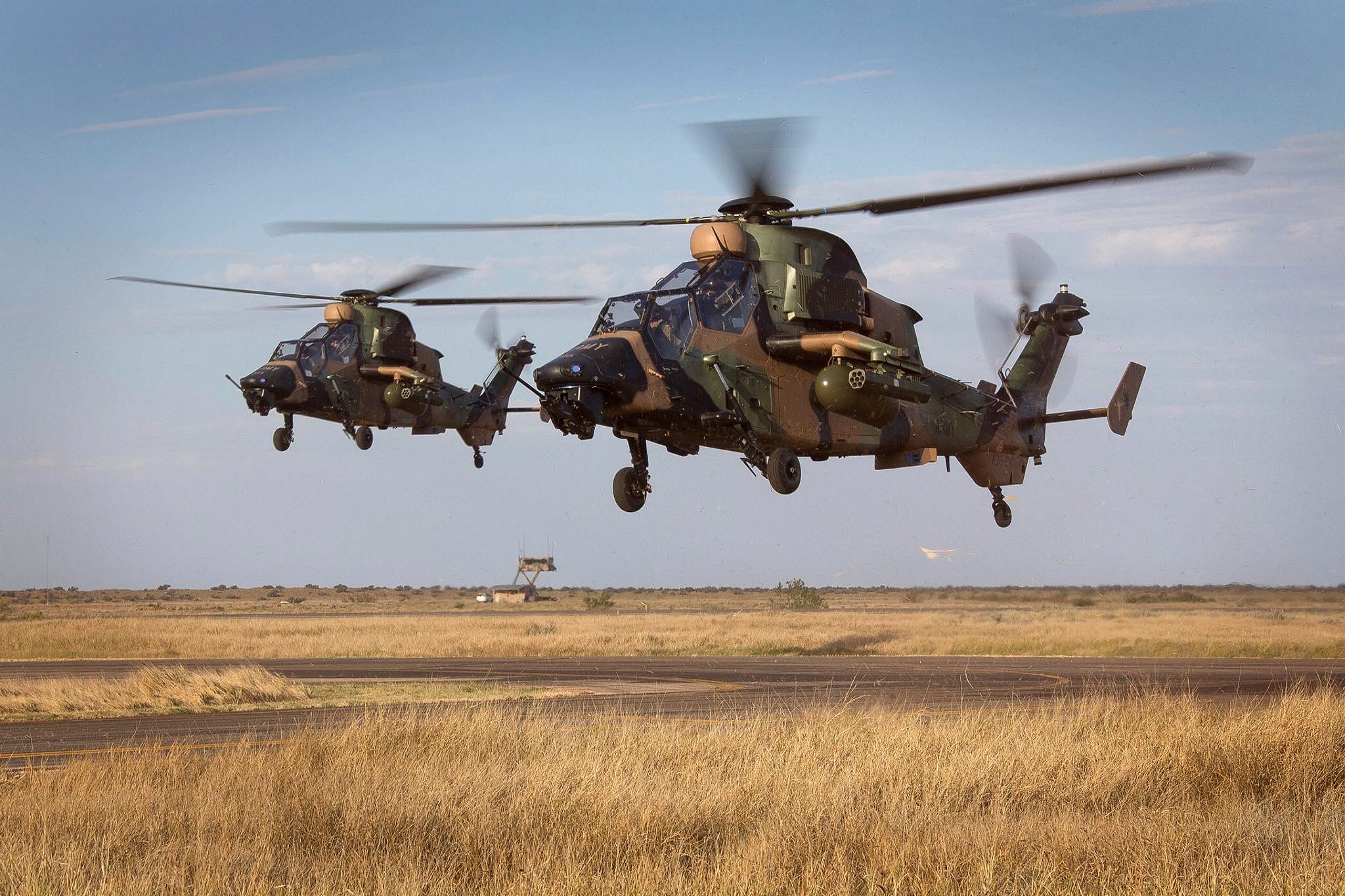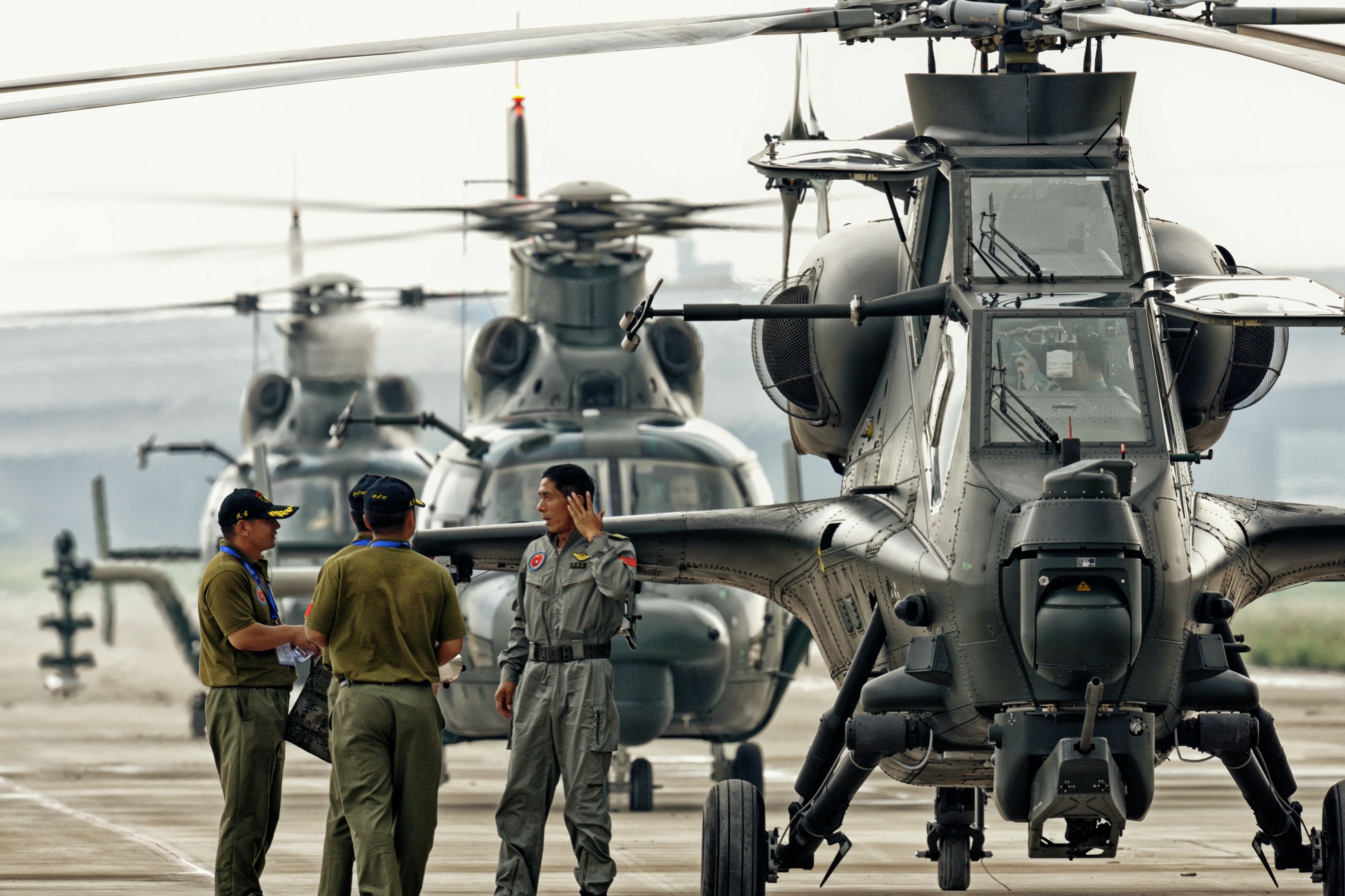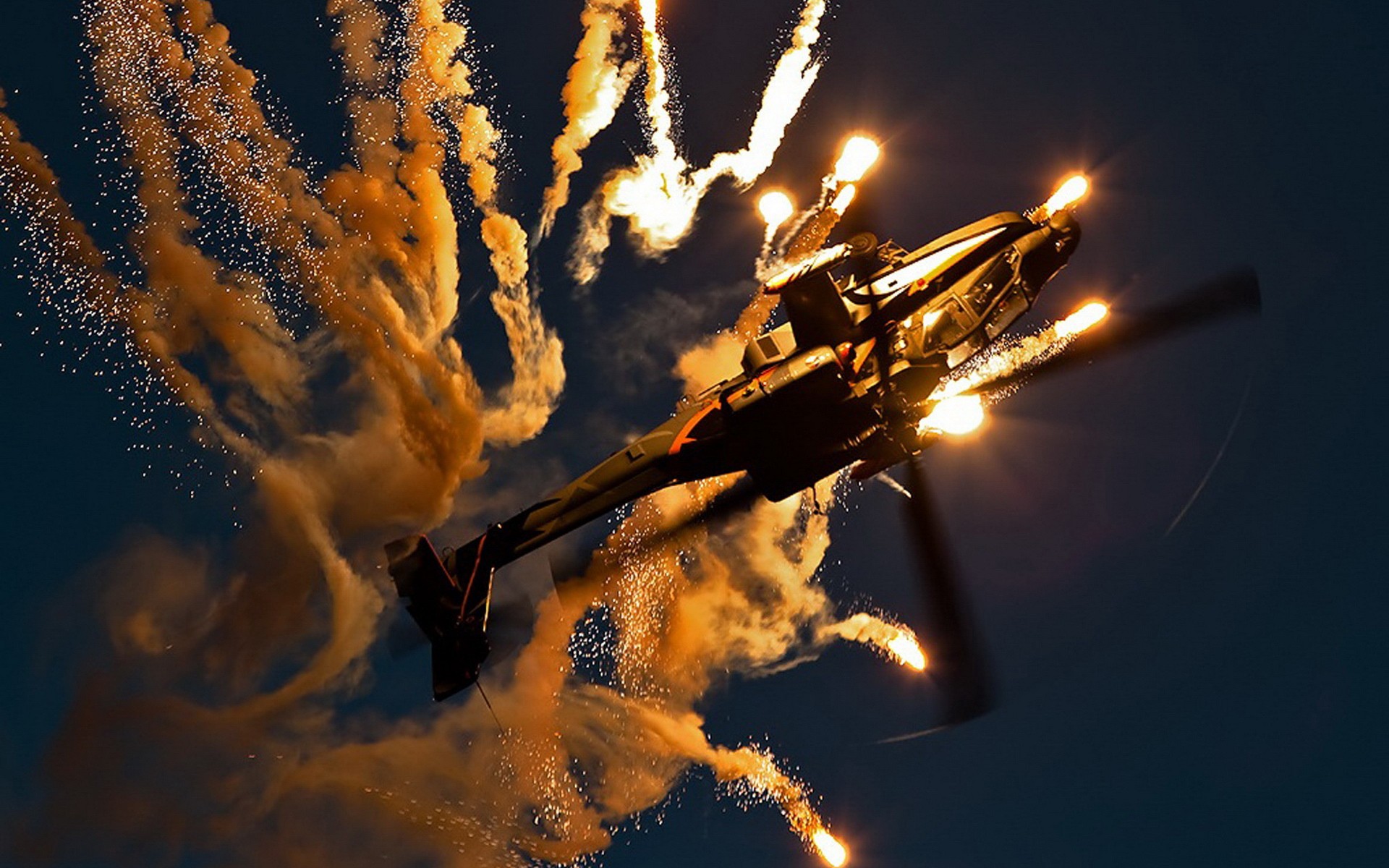Top 10 Attack Helicopters

Bing Chandler is a former Lynx Observer (think Weapon Systems Officer) who has since spent far too much time arguing about helicopters while working at Joint Helicopter Command, and the Army Air Corps Centre at Middle Wallop. We asked Bing to choose the ten best attack helicopters in service today.
“Attack helicopters, because if you thought normal ones were as ugly as an aircraft could get, the world’s defence contractors conspired to prove you wrong. To get on the list, the aircraft has to be in service and armed with an integrated gun and missiles. Disappointingly, this meant I had to exclude the Alouette III, one of which managed to shoot down an Islander with a 20-mm door gun — providing a service to aviation enthusiasts everywhere.
Follow my vapour trail on Twitter: @Hush_kit
10. Eurocopter/Airbus Helicopters Tiger ‘Tyger Tyger, burning crap’

The Tiger is essentially only on this list because it appeared in the film Goldeneye and I’d ruled out the Harbin Z-19 and Kawasaki OH-1 for not having guns. Although admittedly some Tigers don’t have guns either because it’s that bad an attack helicopter. As an example of European cooperation it’s up there with the Seven Years War, except that didn’t take as long to reach a conclusion. A joint Franco-German requirement was issued in 1984, and the maiden flight of a Tiger took place in 1991. Fast forward 11 years and they finally start rolling off the production line, reaching full operational capability at the end of 2008, the JSF programme office are probably the only people in the world to view that as rapid development. Meanwhile even when delivered the aircraft were found to be faulty, Germany at one point suspending deliveries due to serious defects, while in 2012 Australian pilots refused to fly their aircraft due to the number of cockpit fume incidents. In fact so enamoured of the Tiger are the Australians that despite only reaching full operating capability in 2011 they’re already planning on replacing it from the mid 2020s. Meanwhile investigators still haven’t determined why a German aircraft operating in Mali flew into the ground from 1800’, guidance limiting max speed and autopilot use hardly being reassuring. Still that scene in Goldeneye when they eject out of it is totally worth the €14.5Bn development cost.
9. HAL Light Combat Helicopter (LCH) ‘Backseat Dhruver’

The Hindustan Aeronautics Ltd Light Combat Helicopter was developed from that companies Dhruv utility helicopter, which itself looks suspiciously like an MBB Bo 105. Well not that suspiciously, MBB helped develop it. The LCH takes what you’ll soon discover reading this list is a tediously formulaic approach to producing an attack helicopter, i.e. give it a narrow fuselage, seat the crew in tandem, tail dragger undercarriage, gun and sensors somewhere near the front and stub wings for rockets and missiles. The usual features of helmet mounted sights, laser and radar warning receivers, missile approach warning receivers, data links etc. are all present, however at the moment only a limited number have been produced, with full rate production only starting last year, making it too early to establish its actual capabilities.
8. Denel Rooivalk ‘Tshwane’s World’

Eventually, even Britain and France were banned from selling the South African apartheid regime weapon systems, leading the pariah state to create its own. With a fast moving border war and the threat of Soviet armour, the South African army looked with envy to the gunship helicopters by the US and the USSR. The Rooivalk, or Red Kestrel, was developed from the mid-1980s by Denel building on earlier work that had made a proof-of-concept gunship out of an Alouette III. To simplify the task while operating under a UN embargo the dynamics were taken from the Atlas Oryx, a licence built Puma, while it also used the Turbomeca Makila engines of the Super Puma. This allowed for a reasonably large helicopter, the Rooivalk being noticeably bigger than the similar looking Mangusta, with an empty weight of 5739kg —more than the Mangusta’s maximum take-off weight! The embargo that had led to the creation of their attack helicopter also forestalled a range of weapons being integrated on to it. The solution to this was the development of indigenous systems, such as the ZT6 Mokopa anti-tank missile. This seriously limited the export potential as most countries include Hellfire integration as a key user requirement. Attempts were made to market the aircraft to the UK, Malaysia, and Turkey however all selected alternatives or suffered an economic crash that led to the cancellation of any planned procurement. Consequently the Rooivalk is most notable for having the smallest production run of any aircraft on this list with only 12 rolling out of the factory for use by the SAAF’s 16 squadron.

The Hush-Kit Book of Warplanes Vol 3 is 100% crowd-funded, so needs your support to happen! All you need to is to pre-order your copy here.
7. Agusta/Agusta Westland/Leonardo Helicopters Mangusta ‘Alpine Mongoose’

The Mangusta was developed in the late 70s and early 80s by Agusta to fulfil an Italian Army requirement for a light observation and anti-tank helicopter. This was intended to guard against a potential Warsaw Pact armoured thrust against Italy’s border with Yugoslavia, the only effective direction of attack thanks to the Alps. Coming to the same conclusions as the design teams for the Cobra and Apache, the Mangusta followed the emerging trend for attack helicopter design that would soon become drearily monotonous. Operations in Somalia in the early ‘90s revealed several shortcomings, leading to the requirement for a gun, full NVG capability, and an improved navigation system. Agusta incorporated all of these features on the A129 International variant as well as replacing the original licence built Gem gas turbines with LHTEC T800s (developed for the cancelled RAH-66 Comanche) for improved performance, the A129 having had to operate at the edge of its ability in the scorching heat of Somalia. The Italian Army meanwhile had the improvements retrospectively applied to its aircraft (apart from the engine upgrade). The TAI/Leonardo T129 ATAK is essentially the A129 International with modifications to meet Turkish requirements, and presumably to update components that had become obsolete in the 20 years between the International being proposed and someone actually buying it. In 2015 the Italian Army announced they were planning on upgrading their Mangusta to improve endurance, speed, and situational awareness, the alternative of developing a new attack helicopter from the AW149 being considered too risky.

6. Chinese Aircraft Industries Group (CAIC) Z-10 ‘The Changhe Comanche’


The Hush-Kit Book of Warplanes will feature the finest cuts from Hush-Kit along with exclusive new articles, explosive photography and gorgeous bespoke illustrations. Order The Hush-Kit Book of Warplanes here
In a shock move, the Chinese Z-10 attack helicopter features a crew of two in an armoured tandem cockpit, stub wings for weapons carriage, and a 20mm cannon in a nose turret. Okay, so essentially it’s the same as the Tiger, Mangusta, Rooivalk or any other modern attack helicopter, and dear reader I’m not convinced I’d identify it correctly in a recce test never mind in flight. The Z-10 Fiery Thunderbolt is however probably the only aircraft to be named after a knock off MacBook accessory. The Z-10 is, inadvertently, a true multi-national effort, in the mid-90’s Kamov were contracted to provide an initial design which the Chinese would develop and refine. Eurocopter and Augusta provided assistance, the latter being paid $30 million for work related to the transmission system. Meanwhile to prove they were team players in 2012 the US Government successfully prosecuted United Technologies for breaking ITAR regulations in relation to software exports for the Z-10 programme. The prototypes originally flew with P&W PT6 turbines but production aircraft have a domestically produced engine along with upturned exhausts to reduce the IR signature. Combined with at least a modest attempt at RADAR Cross Section reduction through careful matching of external angles the Z-10 has the potential to be an effective light attack helicopter. 5. Kamov Ka-50/52 (NATO codename ‘Hokum’) ‘See you much later, Alligator’ It was tempting to put Kamov’s entrant higher up the list just because it looks different, however this leads to some disadvantages compared to its contemporaries. Produced in response to the same requirement that led to the Mi-28 the Hokum features a coaxial twin rotor, and side by side seating. Chosen to fulfil the requirement the original Ka-50 was a single pilot aircraft, it being thought automation would reduce the workload to an acceptable level. However as the programme progressed an improved variant with more sensors led to a second crew member and the side by side seating arrangement. With broadly similar armament to the Havoc the Hokum is disadvantaged by the side by side seating configuration, which restricts each crew members field of view compared to the traditional tandem layout. Meanwhile although the coaxial rotor system has benefits in terms of yaw inertia and hover performance it has shortcomings in overall manoeuvrability in order to avoid the risk of blades colliding. Observers have noted that during displays it only makes sharp turns in a climb, and then only to the left as a turn to the right would risk blade collision. Indeed a 1998 crash of a Ka-50 was put down to hard manoeuvring leading to the blades hitting each other. Consequently although heavily armed the Hokum is too limited by its design to move higher up this list, it’s almost as if the clone like similarity of attack helicopters is for a good reason. 4. Mil Mi-24/25/35 (NATO codename ‘Hind’) ‘Krokodilbert’ The first Soviet attack helicopter was conceived as a flying Infantry Fighting Vehicle, thus as well as a selection of anti-tank missiles and a turret mounted .50 cal machine gun it can also carry 8 combat troops*. After trialling the idea with the Mi-24A which for some reason grafted a conservatory to the front of the aircraft for the pilot and weapon system operator to sit in, the Russians perfected it with the D variant giving the crew a tandem cockpit to sit under, and the similar E which swapped the .50 cal for a fixed twin barrelled 30mm cannon. This cockpit was then armour-plated and along with the cabin pressurised to prevent chemical or biological agents getting in. At least until the troops want to get out. As well as being heavily armed the ‘Hind’ is also fast and uses this speed to make up for a lack of manoeuvrability if it has to engage with other attack helicopters as happened during the Iran-Iraq war. During the Soviet War in Afghanistan to ensure aircraft availability in the harsh operating conditions time expired engines were kept on the aircraft until they’d accumulated a further 50 hours of ‘life after death’. Other parts would deliberately only be replaced when they finally failed, which is possibly taking conditional maintenance a step too far but does demonstrate the ruggedness of the design. The ‘Hind’ has taken part in a bewildering array of conflicts and insurgencies starting in Ethiopia in 1978 and continuing to the present day. Tough, well armed, and uniquely for an attack helicopter able to deploy a section of troops, the Hind continues to live up to its Mujahideen nickname of the Devil’s Chariot. *Re ED. Could the Hind carry troops and substantial weapon loads at the same time? Bing: It’s a bit of a grey area, looking at some numbers I think the Hind could carry troops and external weapons although probably not the max possible. They seem to demonstrate the capability in the video of this exercise http://www.thedrive.com/the-war-zone/12267/watch-this-russian-mi-35-hind-do-what-no-other-attack-helicopter-can although the rocket tubes are notably empty at one point that may be a training limitation or they may have fired them already. 3. Mil Mi-28N ‘Havoc’ ‘Everybody vertalyots sometimes’ Looking like a Soviet Apache the ‘Havoc’ has suffered a development history about as protracted as the Tiger, except in this case due to a lack of interest from the Russian Defence Ministry rather than German indecisiveness. Learning from the experience of operating the Mi-24, a requirement was drawn up in the late ‘70s for a new helicopter that would be a dedicated gunship lacking the ability to carry armed troops. However, a small compartment to carry three personnel remains allowing rescued aircrew to travel in slightly more comfort than sat on the chin pods as they do with the Apache. First flight was in 1982, but by the end of ’84 the Ka-50 had been chosen as the new anti-tank helicopter. This is where things should have ended, however Mil continued development, improving the aircrafts capabilities so that by 1995 the Mi-28N emerged with better navigation equipment to allow night and all weather operation. Showing that perseverance sometimes pays off deliveries of the Mi-28N to the Russian Army started in 2006, over two decades after the first flight. Russia currently has around 60 Havocs with total orders indicating a final buy of around 130 which sounds a lot until you consider the US Army placed an order with Boeing to remanufacture 224 Apaches to the latest standard. 2. Bell AH-1Z Viper ‘Huey Lewis gun’ Born of a need to provide dedicated fire support for US troops in Vietnam, the Huey Cobra was selected as the winner of a competition to provide an interim measure while the AH-56 Cheyenne was developed. Bell’s model 209 entered service with only a few alterations from the competition entrant, devastatingly for those with an eye to aesthetics the retractable skid undercarriage was one of those alterations. So many variants of the Huey and Cobra have now been produced that the designation system is in danger of running out of letters, the AH-1W and AH-1Z being in use with the USMC. The Cobra still shares a transmission, engines, tail etc. with the Huey the UH-1Y having been developed at the same time as the AH-1Z this allowing for a claimed 85% commonality in maintenance significant items. The most obvious external difference to the legacy Cobras is a new four-bladed main rotor which should reduce the vibration levels at slow speed from ‘shocking’ to ‘really it’s fine the instruments are almost readable’ while also improving overall performance and all up mass. The stub wing is also increased in span and gains a missile pylon at the tip, the main advantage of the increase in span however is a repositioning of the inner pylon which previously had to be tilted to ensure jettisoned weapons wouldn’t hit the skids limiting what could be carried there. As an interim measure the Cobra family has now been in service for over 50 years and doesn’t appear to be retiring anytime soon. The Apache was developed by Hughes Helicopters for the programme to replace the US Army’s AH-1 Cobra, first flying in 1975. The first A models entered service in 1986 and three years later were deployed to Panama as part of Operation Just Cause, the following year almost half the US Apache fleet was deployed to Saudi Arabia for Operations Desert Shield and Desert Storm. In 1997 the AH-64D was introduced featuring a glass cockpit, the Longbow fire control radar, a data modem to share targeting information and up-rated engines. The US Army acquired new build D models along with converting their existing A model aircraft, making it the de-facto standard, due to the costs for other users of maintaining the earlier models without the purchasing power of the US driving down the price of parts. The D itself is now being phased out by the AH-64E Guardian which features improved communications and data processing, more powerful T700 engines, and the ability to control UAVs. Initially the Es are being paired with RQ-7 Shadow drones, presumably as a prelude to Judgement Day when the drones take over completely and subjugate mankind as their slave work force. Foreign operators of the Apache include the Netherlands, Japan, Saudi Arabia, Israel, and the UK which selected a modified locally produced variant the WAH-64D. Apart from folding blades to ease operation from the Royal Navy’s carriers the main difference was a change of engine to the RTM322 giving a useful extra 400SHP. This did however alter the centre of gravity and lost some of the advantages of having commonality with the 90% of D models that weren’t made in Somerset. Consequently the UK will from 2020 replace its Apaches with E models from the Boeing production line, reusing high value components where possible. Current production is expected to run until 2026, 50 years after the first example flew and thanks to continual development it remains the standard to beat.” Bing Chandler is a former Lynx Observer (think Weapon Systems Officer) who has since spent far too much time arguing about helicopters while working at Joint Helicopter Command, and the Army Air Corps Centre at Middle Wallop. Follow my vapour trail on Twitter: @Hush_kit Have a look at How to kill a Raptor, An Idiot’s Guide to Chinese Flankers, the 10 worst British military aircraft, The 10 worst French aircraft, Su-35 versus Typhoon, 10 Best fighters of World War II , top WVR and BVR fighters of today, an interview with a Super Hornet pilot and a Pacifist’s Guide to Warplanes Want something more bizarre? The Top Ten fictional aircraft is a fascinating read, as is The Strange Story and The Planet Satellite. The Fashion Versus Aircraft Camo is also a real cracker. Those interested in the Cold Way should read A pilot’s guide to flying and fighting in the Lightning. Those feeling less belligerent may enjoy A pilot’s farewell to the Airbus A340. Looking for something more humorous? Have a look at this F-35 satire and ‘Werner Herzog’s Guide to pusher bi-planes or the Ten most boring aircraft. In the mood for something more offensive? Try the NSFW 10 best looking American airplanes, or the same but for Canadians. 












Without the kindness of our dear readers we could not exist, please donate here. We are extremely grateful to all those who choose to donate.


It says the Huey Cobra was selected as a winner of competition for a dedicated fire support copter in Vietnam. The story that I heard was that the ‘winner’ out of the 5 suppliers who submitted ( Boeing-Vertol ACH-47A, Kaman HH-2C Tomahawk, Piasecki 16H Pathfinder, Sikorsky S-61, and the Bell 209-Cobra.) was the Karman Tomahawk. However Lyndon Johnson had the switch made to Bell as it was from Texas, the same way the TFX winner was switched from Boeing to General Dynamics in Fort Worth.
The Karman Seasprite , then flying for the US navy in its initial single engine version, had a unique servo flap along the blades to control the advance/retreat twist, which improved maneuverability amoung other things.
That’s interesting Duker thank you, have you a source for that?
This wasnt my original source which I think was a book, but this site says the same thing
http://www.aviastar.org/helicopters_eng/kaman_tomahawk.php and they reference another book.
The Hind-E replaced the original wingtip AT-2 Swatter antitank missiles with AT-6 Spirals.
The Hind-F was the version that replaced the 12.7mm nose gun with a 30mm dual-barreled cannon.
Mea culpa, that is correct I think I confused myself trying to condense two decades of development into a sentence!
I had not heard about that before, although it wouldn’t be the first defence contract to be switched at the last moment due to vested interests! I did a bit of reading around and found an alternative explanation that the Kaman was underpowered compared to the Bell, which is true by a few hundred horsepower, but I suspect you’d need access to the US Army test reports to get a better idea of the pros and cons of each design.
Regarding the servo flap, years ago I read that Kaman left Sikorsky to set up on his own after they decided not to use it.
Bing Chandler, I approve of your pseudonym!
Probably my favourite TV character of all times.
Chandler Bing, I approve of your pseudonym!
We want 20 more send them to bealj@bhsconnect.org